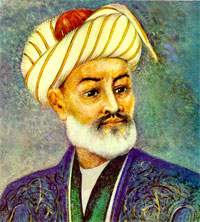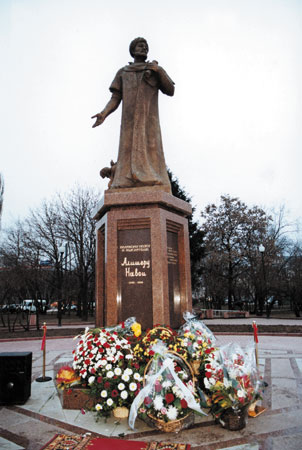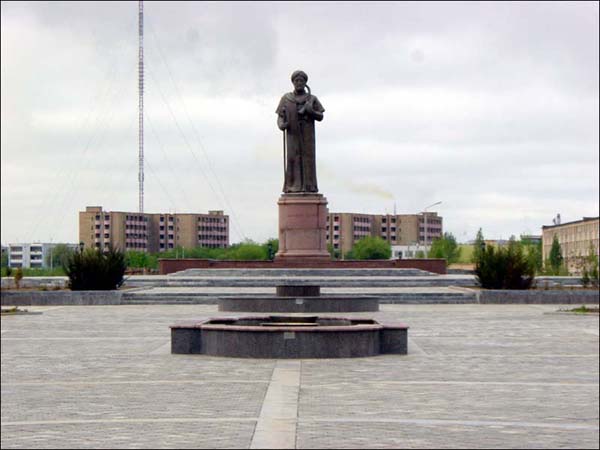<Back to Index>
- Engineer Wilhelm Maybach, 1846
- Poet Nizām-al-Din Alī-Shīr Herawī, 1441
- 9th President of the United States William Henry Harrison, 1773
PAGE SPONSOR

Nizām-al-Din ʿAlī-Shīr Herawī (Chagatai and Persian: نظام الدین على شير هروی; Uyghur:ئەلىشىر نەۋائى; Uzbek: Alisher Navoiy) (9 February 1441 – 3 January 1501) was a Central Asian politician, mystic, linguist, painter, and poet of Uyghur origin who was born and lived in Herat. He is generally known by his pen name Navā'ī (Persian: نوایی, meaning "the weeper"). Because of his distinguished Chagatai (Middle Turkic) poetry, he is considered by many throughout the Turkic speaking world to be the founder of early Turkic literature.
Mīr Alī Shīr was born in 1441 in Herat, which is now in northwestern Afghanistan. He belonged to the Chagatai amir (or Mīr in Persian) class of the Timurid elite. His father, Ghiyāth ud-Din Kichkina ("the Little"), served as a high ranking officer in the palace of Shāhrukh Mirzā, the ruler of Khorasan. According to contemporary historian Mirza Muhammad Haidar Dughlat (1499 - 1551), he was a descendant of Uyghur "Bakhshis" - originally scribes serving in the Mongol Empire who often put orders, issued by Chengiz Khan and
his descendants, in shape of verses, declaring by loud voices - many of
whom later served at the courts of almost all Chagatai and Timurid
rulers and later became powerful military officials (thus the military
title Mīr).
His mother served as a princes' governess in the palace. His father
died while Mīr Alī Shīr was young, and the ruler of Khorasan, Babur Ibn-Baysunkur, adopted guardianship of the young man. He was subsequently educated in Mashhad, Herat, and Samarkand. Mīr Alī Shīr was a schoolmate of Husayn Bayqarah, who would later become the sultan of Khorasan. During Mīr Ali Shīr's lifetime, Herat was the capital of the Timurid Empire and became one of the leading cultural and intellectual centers in the Muslim world. It was there that Navā'i met his good friend Jāmī. Mīr
Alī Shīr served as a public administrator and adviser to his sultan,
Husayn Bayqarah. He was also a builder who is reported to have founded,
restored, or endowed some 370 mosques, madrasas, libraries, hospitals, caravanserais, and other educational, pious, and charitable institutions in Khorasan. In Herat, he was responsible for 40 caravanserais, 17 mosques, 10 mansions, 9 bathhouses, 9 bridges, and 20 pools. Among his most famous constructions were the mausoleum of the 13th century mystical poet, Farid al-Din Attar, in Nishapur (northeastern
Iran) and the Khalasiya madrasa in Herat. He was one of the
instrumental contributors to the architecture of Herat, which became, in René Grousset's words, "the Florence of what has justly been called the Timurid Renaissance". Moreover,
he was a promoter and patron of scholarship and arts and letters, a
musician, a composer, a calligrapher, a painter and sculptor, and such
a celebrated writer that Bernard Lewis, the distinguished English historian of Islam, called him "the Chaucer of the Turks".
Under the pen name Navā'i, Mīr Alī Shīr was among the key writers who revolutionized the literary use of the Turkic languages. Navā'ī himself wrote primarily in the Chagatai language and
produced 30 works over a period of 30 years, during which Chagatai
became accepted as a prestigious and well respected literary language.
Navā'i also wrote in Persian (under the pen name Fāni), and to a much lesser degree in Arabic and Hindi. Navā'ī's best-known poems are found in his four divans,
or poetry collections, which total roughly 50,000 verses. Each part of
the work corresponds to a different period of a person's life: Ghara’ib al-Sighar ("Wonders of Childhood"), Navadir al-Shabab ("Rarities or Witticisms of Youth"), Bada'i' al-Wasat ("Marvels of Middle Age"), Fawa'id al-Kibar ("Advantages of Old Age").
To help other Turkic poets he wrote technical works such as Mizan al-Awzan ("The Measure of Meters"), and a detailed treatise on poetical meters. He also crafted the monumental Majalis al-Nafais ("Assemblies
of Distinguished Men"), a collection of over 450 biographical sketches
of mostly contemporary poets that is a gold mine of information for
modern historians of Timurid culture. Navā'i's other important works include the Khamsa (quintuple), which is composed of five epic poems and an imitation of Nezami Ganjavi's Khamsa: Hayrat-ol-abrar (Wonders of Good People) (حیرت الابرار), Farhad va Shirin (فرهاد و شیرین), Layli va Majnun (لیلی و مجنون), Sab'ai Sayyar ("Seven travellers (planets)", سبعه سیار), Sadd-i-Iskandari ("Alexander's Dam", سد سکندری , an epic poem about Alexander the Great). He also wrote Lisan-ol-tayr (لسان الطیر or "Language of Birds", following Attar's Manteq-ol-tayr منطق الطیر or Speeches of Birds), in which he expressed his philosophical views and Sufi ideas. He translated Jami's Nafahat-ol-ons (نفحات الانس) to Chagatai Turkic and called it Nasayim-ul-muhabbat (نسایم المحبت). Hi Besh Hayrat (Five
Wonders) also gives an in-depth look at his views on religion and
Sufism. His book of Persian poetry contains 6000 lines (beit).
Perhaps his most passionate work was his last, Muhakamat al-Lughatayn ("Judgment
between the Two Languages"), completed in December 1499. He believed
that the Turkic language was superior to Persian for literary purposes,
and defended this belief in his work. It was the writer’s last
definitive statement on the subject dearest to his heart; the Muhakamat acted as the author's last will and testament.
Repeatedly, Nava'i emphasizes his belief in the richness, precision and
malleability of Turkic vocabulary as opposed to Persian.

